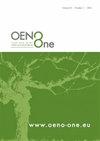通过作物强迫对葡萄植株进行冠层管理。“Touriga Nacional”的性能,成熟和浆果代谢组学分析
IF 2.2
3区 农林科学
Q3 FOOD SCIENCE & TECHNOLOGY
引用次数: 3
摘要
气候变化正在加速世界上许多地区的葡萄成熟,包括地中海盆地,但温度升高往往会使技术成熟度和酚类成熟度脱节,导致葡萄酒不平衡。我们测试了作物强迫(CF)对延迟cv成熟的效果。研究了杜罗河地区“Touriga Nacional”葡萄树及其对植株性能、果实品质属性和代谢组的影响。在连续两个季节(2019年和2020年),CF在坐果后15 (CF1)和30 (CF2)天进行,通过树篱将枝条生长到5节,去除夏季侧枝、叶子和簇。结果表明,CF2处理将葡萄成熟期推迟了51天,直至秋初降雨,影响了葡萄的最佳成熟期,而CF1处理将技术成熟期推迟了1个月,但两种处理都严重影响了葡萄产量,其中CF1处理影响最大,使葡萄产量降低了90%。从两个季节叶片黎明前水势的测量值来看,CF对葡萄抗干旱胁迫的保护作用并不明显。与对照相比,CF1和CF2的果实pH值较低,可滴定酸度较高,而总酚类物质含量在2020年增加了48%。一项基于ulc - ms的目标代谢组学分析显示,CF增加了关键代谢物的相对丰度,如黄烷-3-醇(即儿茶素-没食子酸酯增加了661%),三羟基花青素(即蒲草苷-3-o -葡萄糖苷增加了656%)和二苯乙烯(白藜芦醇增加了700%),对葡萄酒质量有潜在的积极影响。本文章由计算机程序翻译,如有差异,请以英文原文为准。
Canopy management through crop forcing impacts grapevine cv. ‘Touriga Nacional’ performance, ripening and berry metabolomics profile
Climate changes are speeding up the maturation of grapes in numerous areas of the world, including in the Mediterranean basin, but warmer temperatures often uncouple technical and phenolic maturity, resulting in unbalanced wines. We tested the efficacy of crop forcing (CF) in delaying the maturation of cv. ‘Touriga Nacional’ vines of the Douro Region, and their impacts on plant performance, berry quality attributes and metabolome were also evaluated. In two consecutive seasons (2019 and 2020), CF was conducted 15 (CF1) and 30 (CF2) days after fruit set by hedging growing shoots to five nodes and removing summer laterals, leaves and clusters. Results showed that while CF2 delayed ripening up to 51 days till first autumn rainfall, which compromised optimal sugar ripeness, CF1 delayed the technical maturation by one month, but both treatments severely impacted the production, mainly CF1, which reduced grapevine yield up to 90 %. The effect of CF in protecting vines against drought stress was not evident, judging by the values of leaf pre-dawn water potential measured along both seasons. CF1 and CF2 resulted in berries with lower pH and higher titratable acidity than controls, while total phenolics content increased by up to 48 % in 2020. A UPLC–MS-based targeted metabolomic analysis showed that CF increased the relative abundance of key metabolites like flavan-3-ols (i.e., catechin gallate increased by up to 661 %), trihydroxylated anthocyanins (i.e., delphinidin-3-O-glucoside increased by up to 656 % after CF2) and stilbenes (resveratrol increased by up to 700 % after CF2) with potential positive impacts in wine quality.
求助全文
通过发布文献求助,成功后即可免费获取论文全文。
去求助
来源期刊

OENO One
Agricultural and Biological Sciences-Food Science
CiteScore
4.40
自引率
13.80%
发文量
85
审稿时长
13 weeks
期刊介绍:
OENO One is a peer-reviewed journal that publishes original research, reviews, mini-reviews, short communications, perspectives and spotlights in the areas of viticulture, grapevine physiology, genomics and genetics, oenology, winemaking technology and processes, wine chemistry and quality, analytical chemistry, microbiology, sensory and consumer sciences, safety and health. OENO One belongs to the International Viticulture and Enology Society - IVES, an academic association dedicated to viticulture and enology.
 求助内容:
求助内容: 应助结果提醒方式:
应助结果提醒方式:


